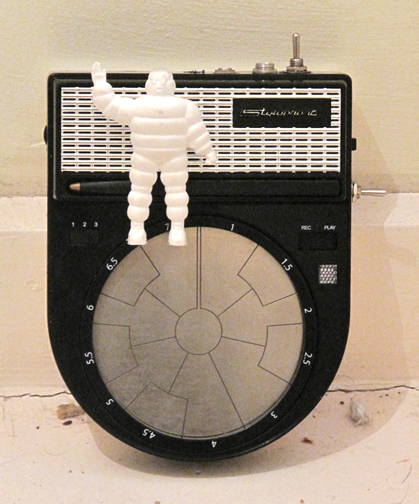[Edit: the BigBoy, alas, is no more! I irreparably damaged the circuit . . . but now it lives on in the BigBoy Beatbox, which is described here].
The creation of the Big Boy came about as the result of the blindingly simple, though ultimately pointless idea of transplanting the workings of a Stylophone into the body of a Stylophone Beatbox.
I had a number of broken donor Beatboxes, and proceeded to dismantle one of these. There are 12 ‘keys’ on the circular board, laid out in a similar way to piano keys, or the keys of a Stylophone, so one octave was available. I decided there should be three octaves, so had two challenges: one, to connect the Beatbox keyboard to the Stylophone keyboard; two, to add switches to change octaves.
Connecting the two boards together proved fairly simple. FirstIy I had to saw off the end of the Stylophone board to make it fit into the Beatbox case, and although this made it impossible to use the higher notes, there were still at least 12 left. So I used the lowest 12 keys, soldering one end of a wire to the middle of each key on the Stylophone board, and the other end of the wire to the connection on the edge of the Beatbox board for the appropriate key. It was easy to see which key on the Beatbox board led to which connection on the edge.
There are also two built-in switches on the main Beatbox board, operated by depressing either side of a plastic ring around the keys. I also made connections to these, for later use.
The existing on/off switch was used, with its associated LED, and the space taken by the 3 way slide switch used for selecting the drum, bass or vocal beatbox modes was used for the Stylophone 3 way tone switch. The Beatbox stylus was attached to the place on the Stylophone output board where the Stylophone stylus had been attached.
I carefully removed the Stylophone tuning pot and used it to replace the Beatbox tuning pot on the small board which is attached to the inside of the base of the Beatbox. One end terminal of the pot was attached by a wire to the place it was originally attached to on the Stylophone board; the centre terminal was connected to +V at the same place on the Stylophone output board as the stylus, via a series of preset potentiometers, as described below.
The preset potentiometers were designed to produce the three octaves. If there had been room for a 3 way rotary switch in the body of the Beatbox, this would have been simple. But there wasn’t. There was room for a three way miniature toggle switch of the ON-OFF-ON type, so I decided to use one of these.
With a simple 3 way switch, it would just have required three presets, each adjusted to produce the same note in different octaves; but with the 3 way toggle it required the middle terminal to be permanently connected, and the other two pins – representing the switch in the ‘up’ or ‘down’ position – to be in parallel with the middle terminal resistor. This proved quite complicated, and many adjustments were required before the 3 octaves became available. The Stylophone functions in such a way that the lower the resistance, the higher the pitch. As the rule about two resistors in parallel means that their combined resistance is always lower then the resistance of the lowest of the two, the middle position had to be the lowest octave, and the ‘up’ and ‘down’ positions had to be two octaves higher and one octave higher, respectively.
The integral switches on the board, operated by the plastic ring, duplicated the function of the toggle switch, allowing for momentary octave changes when either the left or right switch was depressed – this only really worked when the toggle switch was in the middle, ‘off’, position, but that was the most practical setting for most uses, I found.
An extra 10k resistor had to be placed in series with the stylus connection, to ensure that the correct pitch could be achieved with the tuning pot roughly in the centre of its travel.



0 Responses to “The Big Boy – Mod 4”